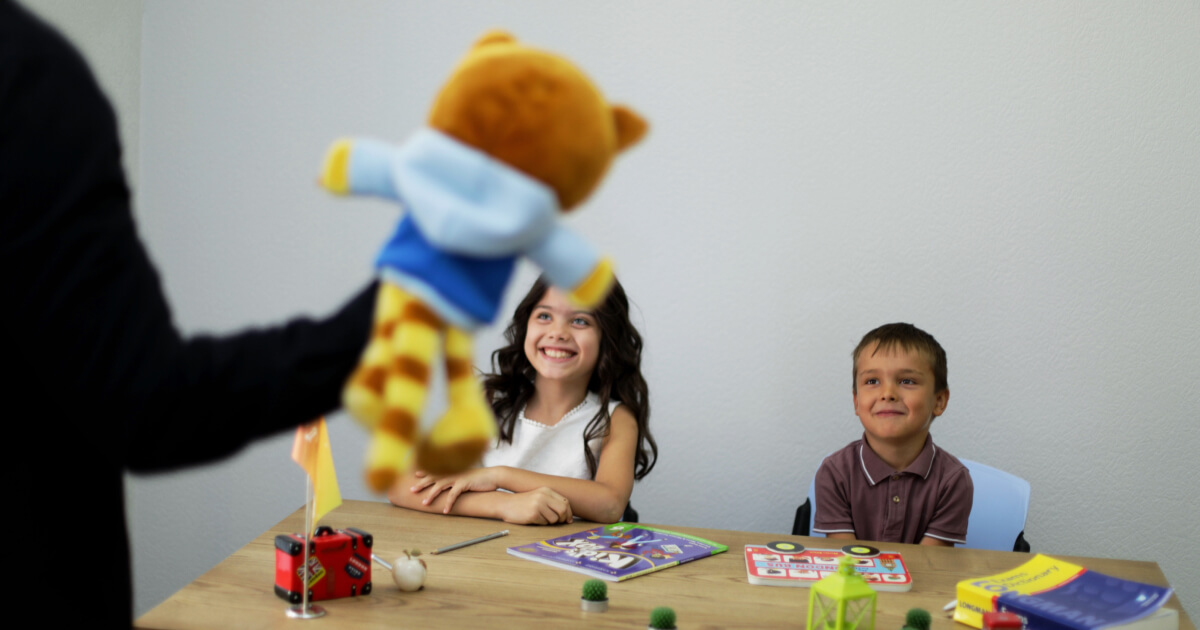Present Continuous: ideas for your lessons
- Teaching qualifications
- Activities
- Tips & Strategies

12.07.2023
Learning grammar is difficult for both children and adults, but it is possible. It is important to understand that children learn, and their brains process information differently, especially language. This should be taken into account when preparing for your lessons.
Another thing is that adults often choose to learn English on their own, whereas younger students usually do so because English is included in the school curriculum or because their parents choose it for them.
Language centers in the child’s brain develop until late adolescence. Children learn their native language by choosing the most relevant words in the context of their own experience. “Mom”, “dad”, “grandma” are the most common words that children learn first.
It is known that just before puberty, children go through a lexical explosion, when the brain switches gears and prepares for adulthood. Children, especially preschoolers, learn through repetition in context, which is the key to their progress. This suggests that they learn language best when it is meaningful and relevant.
Teaching kids with dyslexia
How does this affect the choice of tasks for our young students? Here are some recommendations:
Remember, what works for adults won't always work for children. This means that traditional practice activities that you may have used successfully with adult learners may have limited use for younger learners.
Children respond well to a multisensory approach to learning. Performing certain actions and movements helps them reinforce their understanding of certain concepts.
Multisensory approach to learning — learning technology based on the perception channels of all senses: hearing, sight, touch, smell, taste, which facilitates easier perception and memorisation of the new material.
A wonderful game to play with students is to come up with different actions for each part of speech. For example, put your hands on your head — noun, jump in place — verb, or touch the tip of the nose — adjective.
When you have worked through each action a few times, say the word and ask students to perform the correct action. If you’re playing with a group of learners, encourage each player to complete actions as quickly as possible, and the fastest player wins. The concept of the game is similar to “Simon Says”.

Create an engaging classroom environment!
Learn with our courseThis game is suitable for almost any grammar item. Label each corner in the classroom with the letters A, B, C, D. Next, ask students questions and provide four answer options (A-D) by projecting on the board.
Students move to any corner where the correct answer, in their opinion, is marked. The one who arrives to the wrong corner sits down. If everyone answers correctly, the last person to reach the corner is out of the game.
Alternatively, you can play this game without projecting the answer onto the board. Simply label each corner of your room with the answer and have the students run to the correct one. The game is great for revising verb tenses, prepositions, etc.

Like the previous game, this activity can be adapted to any grammar.
You can adjust the words to any grammatical topic. For example, modal verbs, endings in tenses, singular and plural, parts of speech, etc.
For this game, you can use a story or, for example, the lyrics of a song. Players will need caps or hats. Explain to students that they will need to put on their caps every time they hear words that should begin with a capital letter. To get the most out of the game, choose texts that consist of short sentences that are easy to listen to, and also contain a few proper nouns and possessive adjectives.
Start the game by carefully reading each sentence aloud. Whenever a capital letter is required, the players have to signal by putting their caps on their heads. Remember to use appropriate intonation when reading (such as emphasizing exclamation marks, question marks, pausing, and voicing different characters) and encourage other players to do the same.

Learn more about fun games for your lessons
ReadThis grammar game is simply the best for learning and revising tenses in all sentence forms: negative, affirmative and interrogative. It makes every student participate and also develops team spirit. The activity works best for intermediate students.
Watch the detailed instructions in the following video.
You can also simplify the tasks to the level of your students and use the grammar structure that you are teaching to them.
In this easy grammar game for kids, one player asks the other for specific parts of speech, such as a verb, noun, or adjective, to fill in the gaps in a story. For example, when a player asks for an adjective, another player answers “fluffy”.
When a player fills in all the missing words, he reads aloud a strange story made up of the other player’s suggestions. Not only is it a great way to practice grammar, but it also helps develop storytelling skills and imagination of the students.
5 games to play for great vocabulary!
When you’re looking for activities to use in class, don’t just pick something to fill the time. Tasks can entertain students, but they should also be useful and lead to certain outcomes.
And now let's answer a couple of questions to sum up this article:
Is it a good idea to use the same approach to teach both adults and children?
Every game has to become an integral and useful part of the lesson.
Yulia Chorna
Author
DELTA Module 1, CELTA certified teacher of General & Business English
Comments
Leave your comment